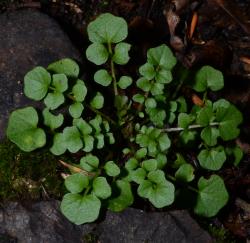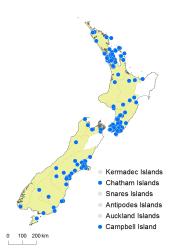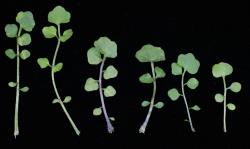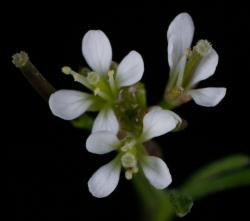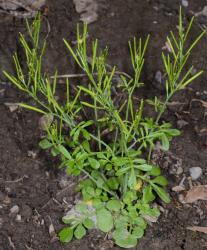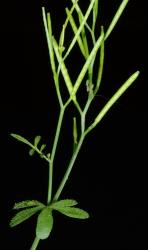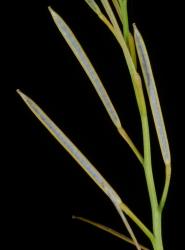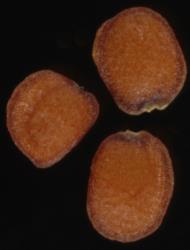Annual herb, single rosette or sometimes several rosettes on short lateral branches; stems erect to ascending. Leaves up to 100 mm long, pinnatisect; lamina 10.0–22.0 × 8.0–18.0 mm, green, membranous, glabrous to sparsely hairy on abaxial surface, sparsely to moderately hairy on adaxial surface, margin, and petiole; hairs 0.4–0.6 mm long, spreading to patent; petiole up to 27 mm long. Terminal pinna 4.0–20.0 × 6.0–20.0 mm, simple, orbicular to reniform; margin entire to shallowly sinuate, with 2–3 ± distinct hydathodes; apex obtuse with a ± distinct hydathode; base cordate, truncate or occasionally obtuse. Lateral pinnae 2–8, 2.0–11.0 × 2.0–6.0 mm, orbicular to broadly elliptic-orbicular; apex obtuse; base often oblique; petiolule 0.4–1.0 mm long. Cauline leaves similar to rosette leaves but smaller, narrower, with fewer lateral pinnae, pinnae bases attenuate to cuneate; terminal pinna up to 7.0 × 2.5 mm, lateral pinnae up to 4.5 × 1.5 mm. Inflorescence racemose, sometimes with lateral racemes, each raceme 6–12-flowered; peduncle up to 130 mm long, 0.6–0.7 mm diam. at base, spreading to ascending, glabrous to sparsely hairy. Pedicels 6.0–8.0 mm long, 0.2–0.5 mm diam., erect or ascending at fruiting, glabrous to sparsely hairy. Sepals 1.5–2.5 × 0.3–0.7 mm, elliptic-oblong, saccate, green to red-brown, sparsely hairy, hairs spreading to patent, margin white and membranous, apex obtuse, base truncate. Petals 3.0–3.8 × 1.4–1.5 mm, white, limb obovate; apex obtuse; base attenuate, tapering to a c. 0.2 mm long claw. Stamens 4(–6); median filaments 1.2–2.2 mm long; anthers 0.3–0.4 mm long, cream to pale yellow, when dehiscent held at a similar height to or slightly below the stigma. Ovary 1.5–1.7 mm long, 0.3–0.5 mm diam., ± terete, green, glabrous or sparsely to moderately hairy; hairs 0.4–0.6 mm long, patent to slightly antrorse; ovules 28–36; style c. 0.2 mm long, ± terete; stigma 0.3–0.4 mm diam. Siliques 10.0–25.0 × 1.0–1.3 mm, glabrous or sparsely hairy, hairs 0.35–0.6 mm long, style 0.2–0.4 mm long; valves green to yellow-green at maturity and when dehiscent; replum 0.2–0.3 mm wide. Seeds 1.0–1.3 mm long, 0.6–0.9 mm wide, 0.2–0.3 mm thick, oblong to broadly oblong, henna-green to henna; wing present at apex and lateral margin, <0.1 mm wide.
North Island: Northland, Auckland, Volcanic Plateau, Taranaki, Southern North Island.
South Island: Western Nelson, Sounds Nelson, Canterbury, Otago, Fiordland, Southland.
Stewart Island.
Chatham Islands.
Campbell Island.
Cardamine hirsuta is naturalised in New Zealand, and is originally from Europe. The glabrous silique form of C. hirsuta occurs throughout New Zealand (including offshore islands). The hairy silique form of C. hirsuta occurs predominantly in eastern areas of the North, South and Stewart Islands.
The hairy and glabrous silique forms of C. hirsuta are both common weeds of parks and gardens in urban areas, of disturbed habitats such as roadsides, waterways and industrial areas, and sometimes of open areas of indigenous vegetation.
In his treatment of C. hirsuta in New Zealand, Kirk (1899) included the autonym C. hirsuta var. hirsuta along with four other indigenous taxa accepted by him as varieties of C. hirsuta. Kirk (1899) is very clear in recognising C. hirsuta var. hirsuta in his treatment by referring to the indigenous taxa having six stamens and explicitly stating four stamens are characteristic of C. hirsuta var. hirsuta. A specimen in the Kirk Herbarium (WELT 62027) is possibly the voucher for this published record, but it lacks a collector, collection date, and locality.
This first record differs from that stated by Garnock-Jones (1979) as being Thomson (1901). Thomson (1901) refers to C. hirsuta in a list of garden weeds, but the location of the first record is not stated and a voucher supporting this record has not been located. Allan (1940) gives "Thomson. 1922" as the first record and states the species occurs in Wellington and Otago.
Flowering January–December; Fruiting January–December.
Cardamine hirsuta and C. flexuosa can sometimes be confused. The two species are easily separated by stamen number, with C. hirsuta having mostly four stamens and C. flexuosa predominantly six stamens. However, stamen number in C. hirsuta can be variable, as noted by Cheo et al. (2001), who report that about 80% of the plants in C. hirsuta they examined have flowers with four stamens and 18% have five stamens. For C. flexuosa they report that 97% of plants have six stamens. In New Zealand a hairy silique form of C. hirsuta is distinguished from the glabrous silique form of C. hirsuta, and this is supported by nrDNA ETS sequence data (Heenan 2017).



